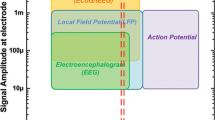Abstract
The future neuro-prosthetic devices would be required spikes data monitoring through sub-nanoscale transistors that enables to neuroscientists and clinicals for scalable, wireless and implantable applications. This research investigates the spikes monitoring through integrated CNT front-end amplifier for neuro-prosthetic diagnosis. The proposed carbon nanotube-based architecture consists of front-end amplifier (FEA), integrate fire neuron and pseudo resistor technique that observed high electrical performance through neural activity. A pseudo resistor technique ensures large input impedance for integrated FEA by compensating the input leakage current. While carbon nanotube based FEA provides low-voltage operation with directly impacts on the power consumption and also give detector size that demonstrates fidelity of the neural signals. The observed neural activity shows amplitude of spiking in terms of action potential up to 80 μV while local field potentials up to 40 mV by using proposed architecture. This fully integrated architecture is implemented in Analog cadence virtuoso using design kit of CNT process. The fabricated chip consumes less power consumption of 2 μW under the supply voltage of 0.7 V. The experimental and simulated results of the integrated FEA achieves 60 GΩ of input impedance and input referred noise of 8.5 nv/\(\rm\sqrt{Hz}\) over the wide bandwidth. Moreover, measured gain of the amplifier achieves 75 dB midband from range of 1 KHz to 35 KHz. The proposed research provides refreshing neural recording data through nanotube integrated circuit and which could be beneficial for the next generation neuroscientists.
Similar content being viewed by others
References
Shepherd, G. Introduction to Synaptic Circuits in the Synaptic Organization of the Brain. Oxford University Press 5th edition (2004).
Parker, A.C., Friesz, A.K. & Pakdaman, A. Towards a Nanoscale Artificial Cortex. Proceedings of International Conference on Computing in Nanotechnology (CNAN’06), 26–29 (2006).
Fatoorechi, M. et al. A comparative study of electrical potential sensors and Ag/AgCl electrodes for characterizing spontaneous and event related electroencephalogram signals. J. Neurosci. Methods. 251, 7–16 (2015).
Guermandi, M., Cardu, R., Scarselli, E.F. & Guerrieri, R. Active electrode IC for EEG and electrical impedance tomography with continuous monitoring of contact impedance. IEEE Trans. Biomed. Circuits Syst. 9, 21–33 (2015).
Lopez, C.M. et al. An implantable 455-active-electrode 52-channel CMOS neural probe. IEEE J. Solid-State Circuits. 49, 248–261 (2014).
Chen, W.M. et al. A fully integrated 8-channel closedloop neural-prosthetic CMOS SOC for real-time epileptic seizure control. IEEE J. Solid-State Circuits. 49, 232–247 (2014).
Barsakcioglu, D.Y. et al. An analogue front-end model for developing neural spike sorting systems. IEEE Trans. Biomed. Circuits Syst. 8, 216–227 (2014).
Demosthenous, A., Pachnis, I., Jiang, D. & Donaldson, N. An integrated amplifier with passive neutralization of myoelectric interference from neural recording tripoles. IEEE Sens. J. 13, 3236–3248 (2013).
Chi, Y.M., Jung, T.P. & Cauwenberghs, G. Dry-contact and noncontact biopotential electrodes: Methodological review. IEEE Rev. Biomed. Eng. 3, 106–119 (2010).
Nelson, M.J. Review of signal distortion through metal microelectrode recording circuits and filters. J. Neurosci. Methods. 169, 141–157 (2008).
Mohseni, P. & Najafi, K. A fully integrated neural recording amplifier with DC input stabilization. IEEE Trans. Biomed. Eng. 51, 832–837 (2004).
Steyaert, M.S.J. & Sansen, W.M.C. A micropower lownoise monolithic instrumentation amplifier for medical purposes. IEEE J. Solid-State Circuits. 22, 1163–1168 (1987).
Wattanapanitch, W., Fee, M. & Sarpeshkar, R. An energy-efficient micro power neural recording amplifier. IEEE Trans. Biomed. Circuits Syst. 1, 136–147 (2007).
Zhang, F., Holleman, J. & Otis, B. Design of ultra-low power bio-potential amplifiers for bio-signal acquisition applications. IEEE Trans. Biomed. Circuits Syst. 6, 344–355 (2012).
Song, S. et al. A low-voltage chopper-stabilized amplifier for fetal ECG monitoring with a 1.41 power efficiency factor. IEEE Trans. Biomed. Circuits Syst. 9, 237–247 (2015).
Toth, L. & Tsividis, Y. Generalization of the principle of chopper stabilization. IEEE Trans. Circuits Syst. I, Fundam. Theory. 50, 975–983 (2003).
Spinelli, E., Haberman, M., Garcia, P. & Guerrero, F. A capacitive electrode with fast recovery feature. Physiol. Meas. 33, 1277–1288 (2012).
Javey, A. et al. Ballistic carbon nanotubes transistors. Nature 424, 654–657 (2003).
Franklin, A.D. & Chen, Z. Length scaling of carbon nanotube transistors. Nat. Nanotechnol. 5, 858–862 (2010).
Kim, Y.B. Integrated circuit design based on carbon nanotube field effect transistor. Trans. Electr. Electron. Mater. 12, 175–188 (2011).
Chi, Y.M., Maier, C. & Cauwenberghs, G. Ultra-high input impedance, low noise integrated amplifier for noncontact biopotential sensing. IEEE J. Emerging Sel. Top. Circuits Syst. 1, 526–535 (2011).
Author information
Authors and Affiliations
Corresponding author
Rights and permissions
About this article
Cite this article
Kumar, S., Kim, BS. & Song, H. An Integrated Approach of CNT Front-end Amplifier towards Spikes Monitoring for Neuro-prosthetic Diagnosis. BioChip J 12, 332–339 (2018). https://doi.org/10.1007/s13206-018-2405-y
Received:
Accepted:
Published:
Issue Date:
DOI: https://doi.org/10.1007/s13206-018-2405-y




